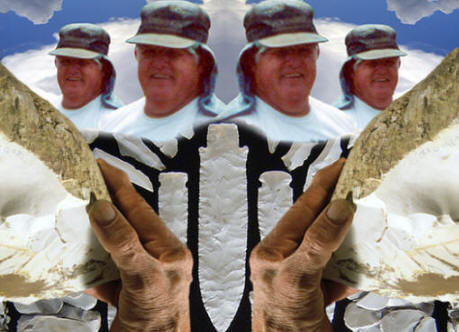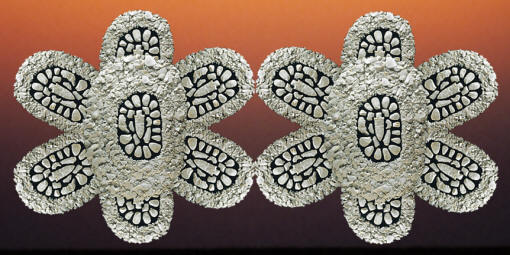|
"Missouri
Archaeology Month is an annual statewide celebration in September to
promote the protection and documentation of Missouri's archaeological
resources. The theme for 2008 is "Ozarks lithic Resources," which were
used by prehistoric Native Americans to make stone tools."---2008,
Missouri Archaeological Society, poster.
"Archaeologists sometimes conduct controlled experiments in which
they manufacture their own stone tools."---1998,
David Hurst Thomas, "Archaeology, Third Edition," p. 71.
"Experimental Archaeology refers to the
application of experimental methods in the data collection and
description, interpretation, and explanation of the archaeological
record."---1996,
Brian M. Fagan, "The Oxford Companion To Archaeology," p. 234.
"The best represented (experimental
studies) are replication experiments
on which artifacts or activities are reproduced. These are well
exemplified by stone-tools replication---"1996,
Brian M. Fagan, "The Oxford Companion To Archaeology," p. 234.

ARTIFACTS PRODUCED
FROM 14 LB NODULE
All the points and tools made for this flintknapping project were
produced by Larry Kinsella at the request of archaeologist Tim Baumann.
For the purpose of illustrating them in the 2008
Missouri Archaeology Month's "Ozarks Lithic resources" themed poster.
The back of the poster illustrates many different types of Missouri
cherts. More information about the Missouri Archaeology Society and this
poster can be found at
www.moarchaeologymonth.info/ or
by phone at 417 836 3773.
|
|
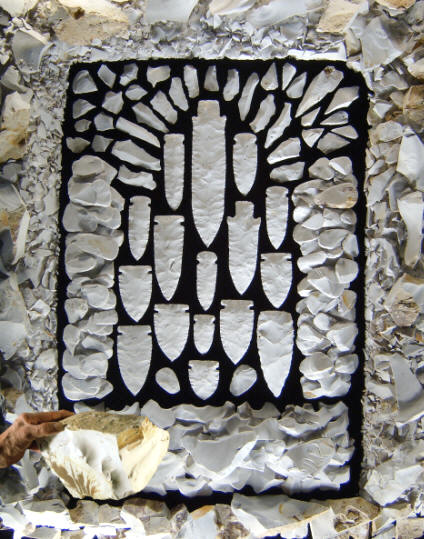
CLICK ON PICTURE FOR LARGER IMAGE
TOOLS & FLAKES PRODUCED FROM
A 14 LB BURLINGTON CHERT NODULE
This picture shows all 16 points, 217 tools and most of the flaking
debris that were produced from the 14 pound
(6.350 kilograms)
nodule. The inset hand is holding the original nodule from which the
artifacts were made. Most of the flakes around the outside edge are rough outer cortex flakes
unsuitable for tool making. The 16 points represented in the center
are Etley, Godar, Matanzas and 1 un-notched biface or cache blade.
The lower pile of flakes, underneath the nodule and to the right,
are spoke shaves. The two piles of tools on the right and left side
of the points are end-scrapers. The long narrow flakes circling the
top of the points are flake knives. The 10 pointed tools at top
right are reamers and the 11 tools with small points at upper left
are gravers. The debris flakes are piled around all four sides. The
total production time to make everything in this picture is 14 hours
and 37 minutes. |
|
|
The goal of the project was to illustrate the number of stone
tools that could be produced from one medium sized chert nodule. The
production began from a single piece of Burlington chert that weighed 14
pounds (6.350 kilograms). It took Larry Kinsella six minutes to reduce the nodule into
many different sizes of flakes or spalls with the use of a quartzite
hammerstone. |
|
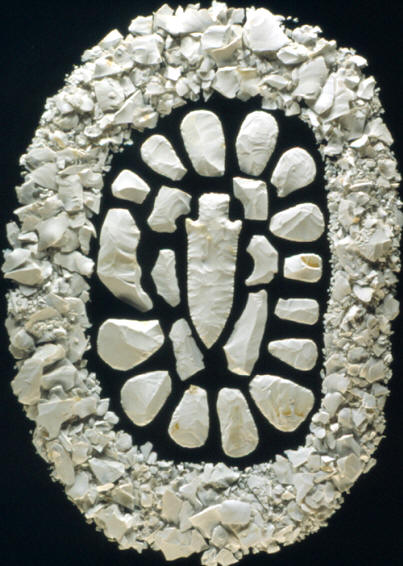
ETLEY POINT & UNIFACIAL TOOLS
PRODUCED FROM ONE
DETACHED FLAKE
These tools were produced from a single large flake. Larry Kinsella
was able to make one Etley point measuring 4 1/4 inches (10.7 cm)
long and several end-scrapers, spoke shaves and 3 flake knives. It
took 51 minutes to make the Etley and 26 minutes to make the 21
unifacial tools. The Etley point was made with a
whitetail deer antler billet, copper
pressure flaker, sandstone abrader, and a copper notcher. |
|
|
The points and
tools produced from the 14 pound (6.350 kilograms) nodule include only
Late Archaic types similar to those found on sites in Missouri and
Illinois. The point types include Etley, Godar, Matanzas, and a Cache
blade or biface. The tools include end-scrapers, spoke shaves, gravers,
reamers, flake knives and burins. A total of 16 points and 217 tools
were produced from the original nodule. |
|
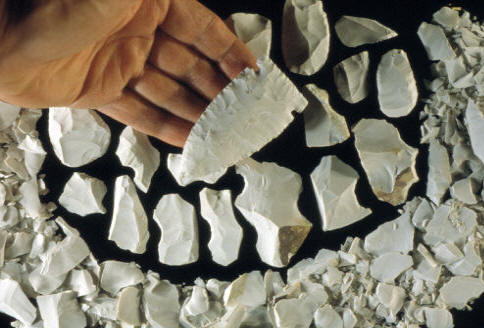
GODAR POINT & UNIFACIAL
TOOLS
PRODUCED
FROM ONE LARGE FLAKE
This Godar point and 19 unifacial tools were produced from one flake
that was detached from the 14 pound nodule
(6.350 kilograms). All the flakes laying along the
edges are waste flakes. The Godar point measures 3 1/4 inches (8 cm)
long and took 40 minutes to make. Larry used
a whitetail deer antler billet, a copper
pressure flaker, sandstone abrader, and a copper notcher to make
this Godar point. The 19 tools include 7 end scrapers, 8 spoke
shaves, 1 graver, 1 flake knife and 2 reamers. The 19 tools took 19
minutes to make. |
|
|
Six different tools were used to complete the project. They include a
quartzite hammerstone, a whitetail deer antler billet, a copper pressure
flaker that is inserted into a whitetail deer antler handle, a copper
notching tool--fashioned similarly to Ishi's, a
sandstone abrader and a split cowhide suede leather leg pad. |
|
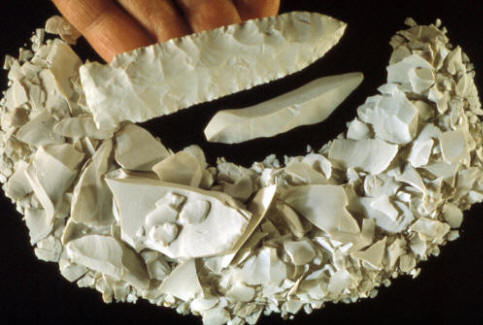
MATANZAS POINT & 1 FLAKE
KNIFE
PRODUCED
FROM ONE LARGE FLAKE
It took 37 minutes to make the
Matanzas point and flake knife pictured above. The Matanzas point
measures 3 1/2 inches (8.9 cm) long. |
|
|
Approximately fifteen large flakes or spalls were detached from the
nodule. Each flake produced one or two points and from 1 to 55 tools.
The production time of each point and for each group of tools was
recorded. The total amount of time to produce all 16 points and 217
tools is 14 hours and 37 minutes. |
|
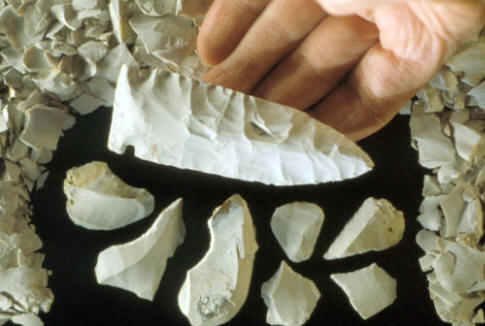
GODAR POINT & 7 UNIFACIAL
TOOLS
PRODUCED
FROM ONE FLAKE
This
Godar point and 7 unifacial tools were made from one flake. The Godar
point measures 3 13/16 inches (9.7 cm) long and took 51 minutes to
make. The unifacial tools are represented by 1 end-scraper, 2
gravers, 3 spoke shaves and 1 reamer. It took 11 minutes to make these
tools. |
|
|
The largest flake that was detached from the 14 pound
(6.350 kilograms) nodule
produced an Etley point measuring 6 11/16 inches (16.9 cm) long and a
Matanzas point measuring 2 7/8 inches (7.3 cm) long. The flaking debris
produced 26 spoke shaves, 25 end-scrapers, 2 flake knives and 2 reamers.
The Etley took 1 hour and 3 minutes to make. The Matanzas took 37
minutes to make and the 55 tools took 1 hour and 29 minutes. |
|
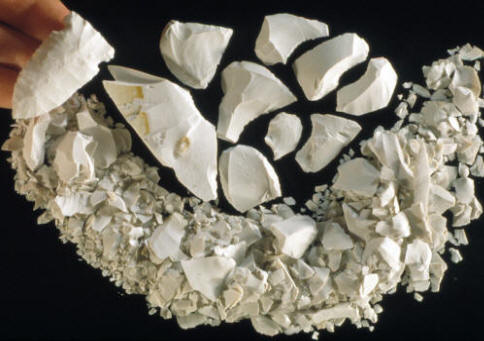
MATANZAS POINT & 9
UNIFACIAL TOOLS
PRODUCED
FROM ONE FLAKE
This Matanzas point and 9 unifacial tools were produced from one
flake or spall that was detached from the 14 pound
(6.350 kilograms) nodule. This
Matanzas point measures 1 1/2 inches (3.8 cm) long and took 24
minutes to make. The unifacial tools are represented by 2
end-scrapers, 1 graver and 6 spoke shaves. It took 6 minutes to make
these 9 tools. |
|
|
Experimental archaeology has been used by scientists, in one form or another, for approximately two hundred
years. The process has been especially useful in the study of stone
tools. Projects such as the one illustrated here are valuable
for the data they produce and for the innovative thinking they project
to others.
More about this project and the Missouri Archaeology Poster can be
found on Larry Kinsella's web site
http://www.flintknapper.com/ |
|
"REFERENCES"
1996,
Fagan, Brian M., "The Oxford Companion To Archaeology," p. 234.
1998,
Thomas, David Hurst, "Archaeology, Third Edition," p. 71.
2008,
Missouri Archaeological Society, poster.
Personal communications with Tim Baumann.
Personal communications with Larry Kinsella.
|
|
RECENT
LISTINGS HOME
ORDERING |
